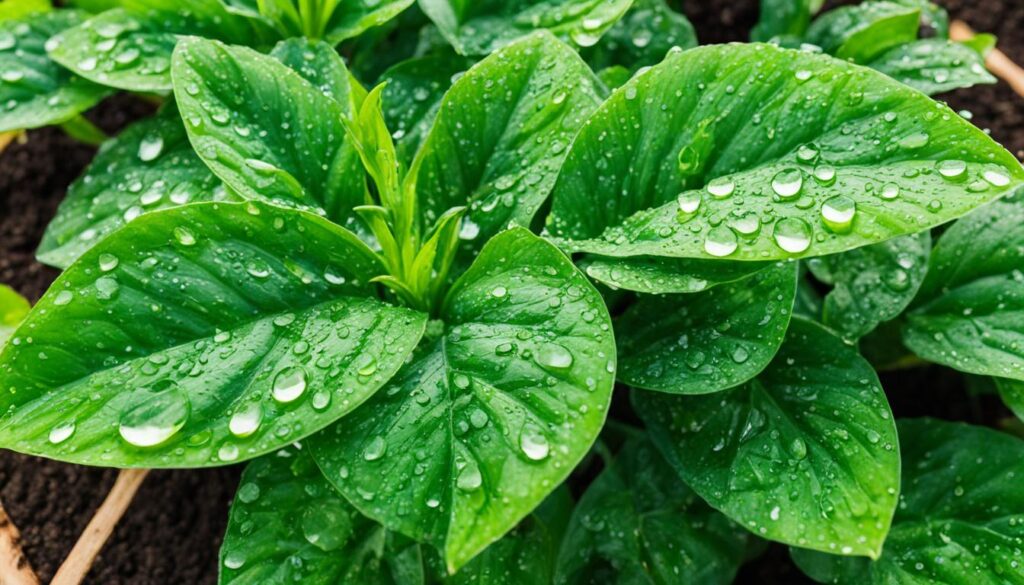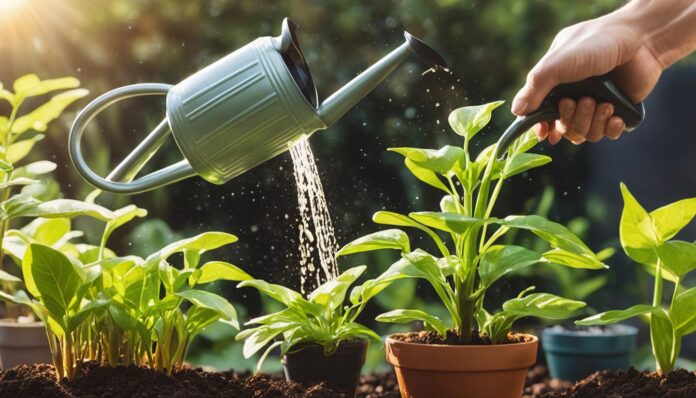Watering plays a crucial role in the health and growth of plants. When plants receive adequate water, it provides structural support, helps cool them down, and facilitates the movement of minerals to the necessary parts. Watering keeps plant cells filled with water, maintaining their stiffness and allowing for upright growth. The process of transpiration, where water evaporates from the leaves, helps plants distribute water to where it’s needed most. The frequency and amount of water needed depends on the type of plant, its natural environment, and the size of the pot. Proper watering techniques, such as checking the soil moisture, using room temperature water, and avoiding overwatering, can ensure plant health and growth.
Key Takeaways:
- Watering is essential for plant health and growth.
- The amount and frequency of watering depend on the plant type, environment, and pot size.
- Proper watering techniques include checking soil moisture, using room temperature water, and avoiding overwatering.
- Transpiration helps distribute water to where it’s needed most in plants.
- Efficient irrigation techniques promote plant health and prevent water wastage.
How Often Should You Water Your Plants?
The frequency of watering plants varies depending on their individual needs. Different plants require different amounts of water based on their natural environments. Succulents, which thrive in hot and dry conditions, prefer less frequent watering. They have adaptations like fleshy leaves and shallow root systems, which allow them to store water for longer periods. On the other hand, tropical plants prefer more frequent watering due to their natural habitat’s high humidity and rainfall.
When determining the watering frequency, it’s essential to consider factors such as pot size, soil type, weather conditions, and the specific needs of each plant. Creating a watering schedule tailored to your plants can prevent drought stress and promote healthy growth.
Adjusting the watering frequency based on the unique requirements of each plant ensures that they receive the right amount of water without overhydration or underwatering. This not only helps the plants thrive but also conserves water resources and contributes to drought prevention. Proper watering techniques play a crucial role in maintaining plant health and vitality.
Below is a table summarizing the watering needs of different types of plants:
| Plant Type | Watering Frequency |
|---|---|
| Succulents and Cacti | Every 2-4 weeks |
| Tropical Plants | Once or twice a week |
| Herbs and Vegetables | Regularly, keeping the soil consistently moist but not waterlogged |
| Indoor Houseplants | Varies by species; usually once a week |
How Much Water Should You Give Your Plants?

When it comes to watering your plants, finding the right balance is crucial for their health and growth. The amount of water plants need depends on several factors, including the type of plant and the size of the pot. Understanding these factors will help you provide efficient irrigation and ensure proper plant hydration.
Smaller pots with less soil tend to dry out faster, requiring more frequent watering. On the other hand, larger pots retain moisture for longer periods, reducing the need for frequent watering. It’s important to strike a balance and avoid overwatering, as it can lead to root rot and other issues.
Proper hydration ensures that plants receive the right amount of water without drowning their roots. Efficient irrigation techniques not only promote plant health but also prevent water wastage.
When watering your plants, aim to saturate the soil up to a specific volume, which can be up to one-fourth or one-third of the planter’s capacity. This ensures that the roots have access to sufficient water while allowing excess water to drain properly.
| Plant Type | Pot Size | Watering Recommendations |
|---|---|---|
| Succulents | Small pots | Water when the soil is completely dry |
| Tropical Plants | Large pots | Water when the top inch of soil feels dry |
| Herbs | Medium-sized pots | Water when the top two inches of soil are dry |
By following these guidelines, you can provide your plants with the optimal amount of water, promoting healthy growth and preventing unnecessary water wastage. Remember to adjust the watering frequency based on environmental factors such as temperature and humidity.
Takeaway:
Efficient irrigation is key to maintaining plant health and conserving water resources. Understanding the specific water needs of your plants and adapting your watering routine accordingly is essential. By ensuring proper plant hydration, you can contribute to the overall well-being of your garden and enjoy thriving, vibrant plants.
How to Water Your Plants Properly
Proper watering techniques are crucial for maintaining optimal plant hydration and promoting healthy garden growth. By following these tried and true watering techniques, you can ensure that your plants receive the right amount of water without over or under watering.
Check the Soil Moisture
Before watering your plants, it’s essential to check the moisture level of the soil. Most plants benefit from allowing the soil to dry out completely between waterings. However, moisture-loving plants may require watering when the soil is mostly dry. Insert your finger about an inch into the soil, and if it feels dry at this depth, it’s time to water your plants.
Use Room Temperature Water
When watering your plants, it’s best to use room temperature water. Extreme temperature differences can shock the plants and hinder their growth. Fill a watering can with water and let it sit for a while to equilibrate to room temperature before watering.
Water Evenly and Avoid Splashing
To ensure thorough saturation, water the potting mix evenly around the plant, but be careful not to create muddy conditions. Slowly pour the water at the base of the plant, aiming to wet the entire root zone. Avoid splashing water onto the foliage, as it can lead to fungal or bacterial spots.
Proper Drainage
For planters with drainage holes, water until you see excess water draining out. This ensures that the roots receive sufficient water, while any excess moisture can escape. Let the water sit in the saucer or cache pot for a while before discarding it, allowing the roots to absorb any remaining nutrients.
Following these watering techniques will ensure that your plants receive the proper hydration they need for healthy growth. It’s an essential part of overall garden maintenance and care.
Seasonal Impact on Watering Needs
The changing seasons have a significant impact on plant growth and, consequently, their watering requirements. As the summer growing season arrives, plants experience increased sunlight and heat, leading to a greater need for watering. This is especially true for houseplants, including succulents, which thrive with more frequent watering during this time.
On the other hand, during the winter season characterized by shorter days and reduced ambient light, plant growth slows down, resulting in decreased water needs. It is important to adjust watering habits accordingly to avoid overwatering the plants.
As spring approaches, plants begin their growth phase again, and their water requirements increase accordingly. Adapting watering habits to the changing seasons ensures that plants receive the appropriate amount of water for optimal growth and health.
Understanding the impact of the seasons on watering needs is essential for maintaining the well-being of your plants throughout the year, promoting healthy plant growth and vibrant foliage.
FAQ
Why is watering important for plant health and growth?
Watering plays a crucial role in providing structural support to plants, cooling them down, and facilitating the movement of minerals. It keeps plant cells filled with water, maintaining their stiffness and allowing for upright growth. Transpiration helps distribute water to where it’s needed most.
How often should I water my plants?
The frequency of watering depends on the type of plant, its natural environment, and the size of the pot. Different plants require different amounts of water. Succulents prefer less frequent watering, while tropical plants may need more frequent watering.
How much water should I give my plants?
The amount of water needed depends on various factors, including plant type and pot size. Smaller pots with less soil dry out faster and require more frequent watering. It’s important to saturate the soil up to a specific volume without overwatering and creating a waterlogged environment.
What are the proper watering techniques for plants?
Before watering, check the soil moisture. Most plants benefit from drying out completely between waterings. Use room temperature water and water the potting mix evenly around the plant. Avoid splashing water onto the foliage. For planters with drainage holes, water until you see excess water draining out.
How does the changing seasons affect watering needs?
During the summer growing season, plants generally require more frequent watering due to increased sunlight and heat. In contrast, the winter season’s shorter days and reduced ambient light result in decreased water requirements. Understanding seasonal changes helps determine the right amount of water for plant growth.

